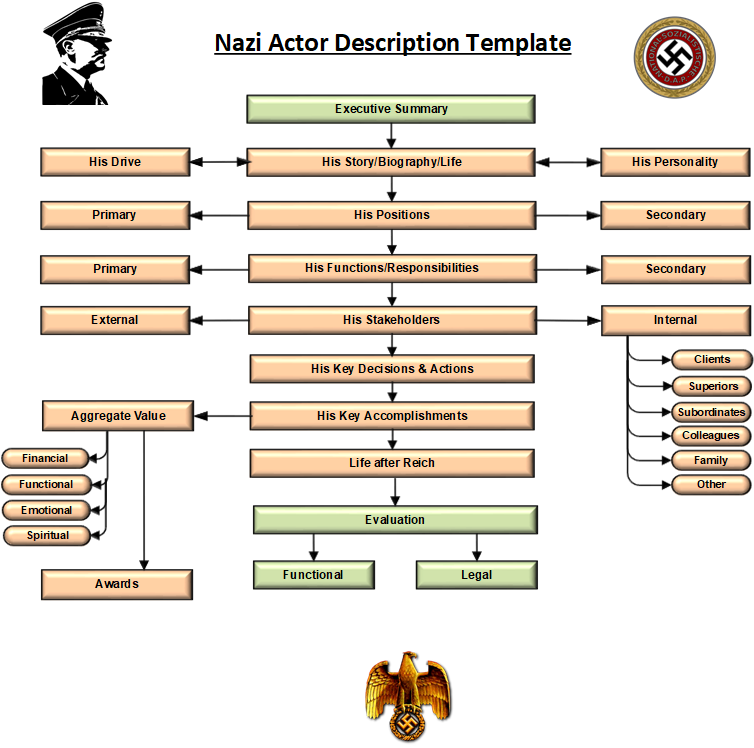
Category: TRDL
Nazi Shareholder Relationship Description Diagram
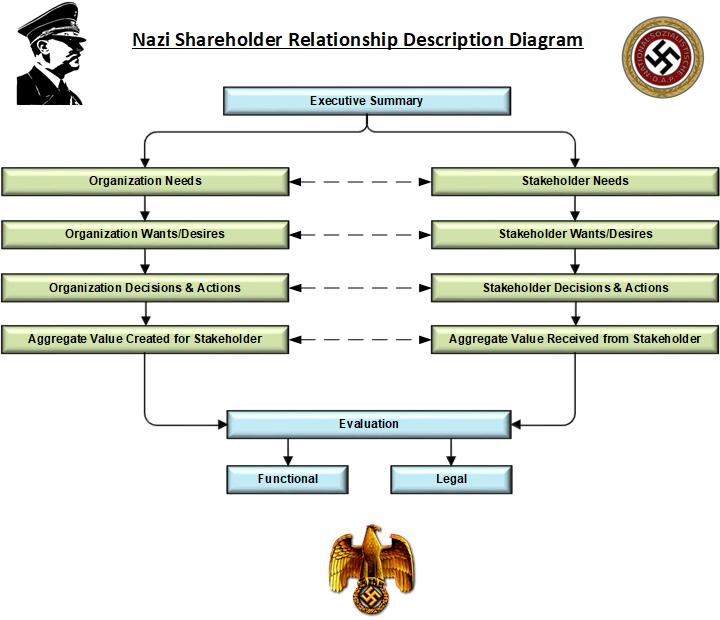
Describing Nazi Stakeholders’ Relationships
 Every organization can survive and prosper only if it creates sufficient amount of aggregate value (financial, functional, emotional and spiritual) for its internal and external stakeholders. In other words, to satisfy the aggregate needs of the latter.
Every organization can survive and prosper only if it creates sufficient amount of aggregate value (financial, functional, emotional and spiritual) for its internal and external stakeholders. In other words, to satisfy the aggregate needs of the latter.
Obviously, relationship with a stakeholder is a two-way street; therefore, a successful and prosperous organization must receive from each of its stakeholders the maximum possible amount of aggregate value as well – according to a fundamental principle of stakeholder harmony: I give, I receive; I receive, I give – in perfect balance.
Actually, one of the key reasons of the demise of the Third Reich was precisely its inability and unwillingness (due to Nazis being national-sociopaths) to satisfy the aggregate needs of the external stakeholders of Nazi Germany.
Consequently, to understand the history of the Third Reich (especially of its spectacular and catastrophic failure), one must understand its relationships with its (especially external) stakeholders.
Which, obviously, must be identified, visualized, structured and analyzed in a uniform way (see Figure A7).
Like the description of any other object in the Nazi system (in object-oriented paradigm relationships are objects, too), the description of stakeholder relationship must begin with executive summary.
Then it is necessary to identify, structure and analyze needs of Nazi Germany (as related to the stakeholder in question) and its wants & desires (which are often different from its genuine needs). And, obviously, needs, wants & desires of the stakeholder in question.
Needs, wants and desires drive decisions made and actions taken by the Nazis and its stakeholders. Decisions and actions that either create or destroy aggregate value. Which, obviously, must be properly measured and analyzed (both ways).
Finally I will perform the “performance evaluation” of the relationship in question. Functional, of course (how efficient it was in creating and receiving aggregate value), but also legal (whether any decision and/or action of the Nazis constituted a crime).
Processes in the Nazi System
Processes (Gestapo investigations, development and production of new military hardware, preventive detention, etc.) are important components of Nazi system (actually, of any organization). Consequently, to produce a genuinely comprehensive and user-friendly guide to Nazi Germany, it is necessary to describe and analyze these processes in a uniform way.
In other words, it is necessary to follow the same process (no pun intended) for the description and analysis of every project in the history of the Third Reich. This process is presented in an easy-to-understand visual form in a Nazi Process. Description Diagram (see Figure A4).
Unlike other objects in the Nazi system, description of Nazi processes needs not one, but three categories of diagrams. In addition to abovementioned diagram, it uses the context diagram (“Level 0”) and the decomposition diagrams (“Level 1” and, if necessary, lower-level diagrams) developed according to the rules, standards and principles of the IDEF0 visualization methodology.
The context diagram template is presented on Figure A5 and the decomposition diagram – on Figure A6.
Obviously, every description of every object in the Nazi system (not just a process), must have an executive summary (as not everyone will have the time to read the whole million-word book).
This description is also developed according to the IDEF0 standards. These standards describe project manager, its subprocesses (jobs, activities, tasks), inputs (products and/or services required by the process), outputs (products and/or services produced by the process), controls (laws, regulations, instructions that process must adhere to); tools used by the process; actors (individuals who perform jobs & activities needed by the process).
Consequently, “all of the above” must be identified, structured and analyzed.
All processes (like all organizations and events) have ultimately one and the same mission – to create the maximum possible amount of aggregate value (financial, functional, emotional and spiritual) for its stakeholders. Aggregate value (created and/or destroyed by the process in question) that must be measured and analyzed.
Therefore I will perform the “performance evaluation” of the project in question. Functional, of course (how efficient it was in achieving its objectives and whether the objectives themselves were good from the aggregate value perspective), but also legal (whether the project or some of its activities constituted a crime).
Nazi Project Description Diagram
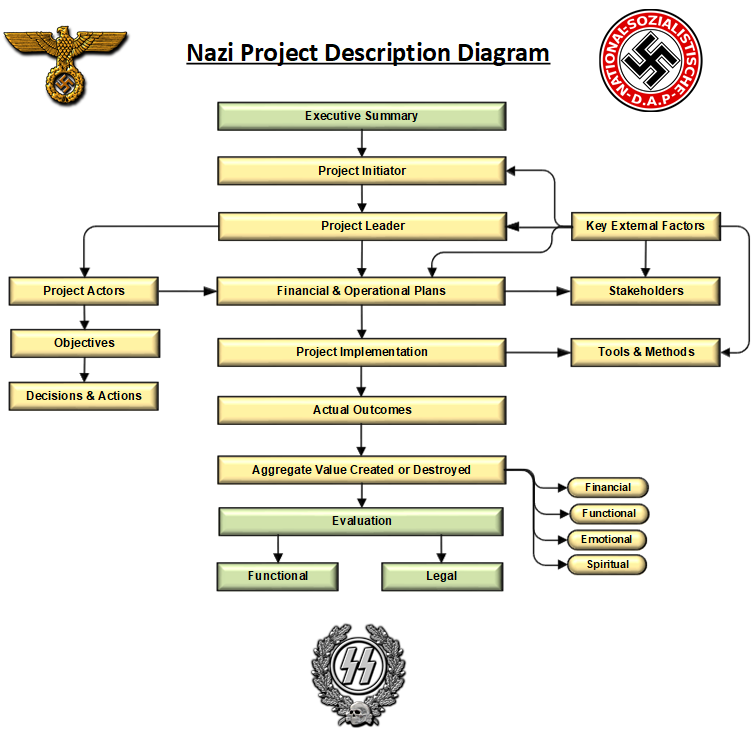
Describing Projects in the History of Nazi Germany
Projects (reengineering of Weimar Republic, elimination of unemployment, creation of Luftwaffe, etc.) are important components of Nazi history (actually, of any organization).
Consequently, to produce a genuinely comprehensive and user-friendly guide to Nazi Germany, it is necessary to describe and analyze these projects in a uniform way.
In other words, it is necessary to follow the same process for the description and analysis of every project in the history of the Third Reich. This process is presented in an easy-to-understand visual form in a Nazi Project Description Diagram (see Figure A3).
Obviously, every description of every object in the Nazi system (not just a project), must have an executive summary (as not everyone will have the time to read the whole million-word book).
Every project (not just in the history of Nazi Germany) is influenced (and often triggered) by a set of key external factors. Which, obviously, must be properly identified, structured and analyzed (in sufficient detail).
Every project has a leader (project manager) and is implemented by actors, who make certain decisions and perform certain actions to accomplish certain objectives (intended outcomes).
To achieve these objectives, project leader and other actors develop and implement plans – financial and operational. And, like an organization and event, every project has its stakeholders. Consequently, “all of the above” must also be properly identified, structured and analyzed.
As well as the project timeline – the sequence (or system, if some of them happen in parallel) of project activities (jobs, tasks, etc.).
All projects (like all organizations and events) have ultimately one and the same mission – to create the maximum possible amount of aggregate value (financial, functional, emotional and spiritual) for its stakeholders. Aggregate value (created and/or destroyed by the project in question) that must be measured and analyzed.
Therefore I will perform the “performance evaluation” of the project in question. Functional, of course (how efficient it was in achieving its objectives and whether the objectives themselves were good from the aggregate value perspective), but also legal (whether the project or some of its activities constituted a crime).
Nazi Event Description Diagram
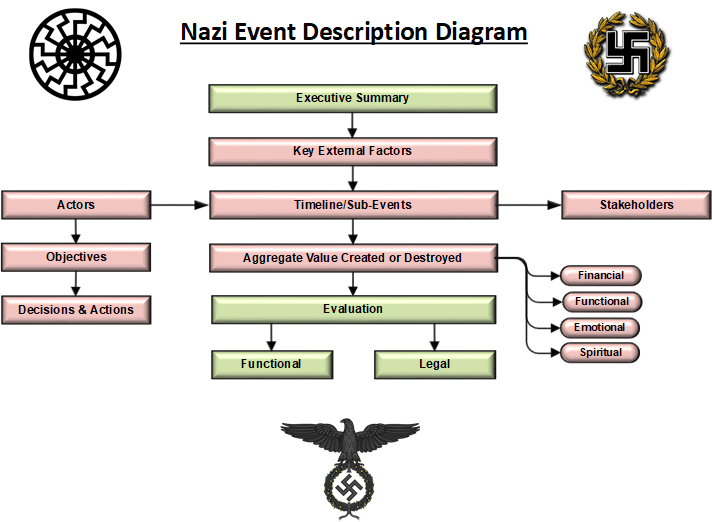
Analyzing Events in the History of Nazi Germany
Another very important component of Nazi system (Nazi history, to be more precise) are, obviously, events. Reichstag Fire, Night of Long Knives, Kristallnacht… even World War II (and World War I, too). Consequently, to produce a genuinely comprehensive and user-friendly guide to Nazi Germany, it is necessary to describe and analyze these events in a uniform way.
In other words, it is necessary to follow the same process for the description and analysis of every event in the history of the Third Reich. This process is presented in an easy-to-understand visual form in a Nazi Event Description Diagram (see Figure A2).
Obviously, every description of every object in the Nazi system (not just an organization), must have an executive summary (as not everyone will have the time to read the whole million-word book).
Every event (not just in the history of Nazi Germany) is influenced (and often triggered) by a set of key external factors. Which, obviously, must be properly identified, structured and analyzed (in sufficient detail).
Every event is implemented by one or (usually) more actors, who make certain decisions and perform certain actions to accomplish certain objectives (intended outcomes). And, like an organization, every event has its stakeholders. Consequently, “all of the above” must also be properly identified, structured and analyzed.
As well as the event timeline – the sequence (or system, if some of them happen in parallel) of sub-events.
All events (like all organizations) have ultimately one and the same mission – to create the maximum possible amount of aggregate value (financial, functional, emotional and spiritual) for its stakeholders. Aggregate value (created and/or destroyed in the event in question) that must be measured and analyzed.
Therefore I will perform the “performance evaluation” of the event in question. Functional, of course (how efficient it was in achieving its objectives and whether the objectives themselves were good from the aggregate value perspective), but also legal (whether the event or some of its sub-events constituted a crime).
Nazi Organization Description Diagram
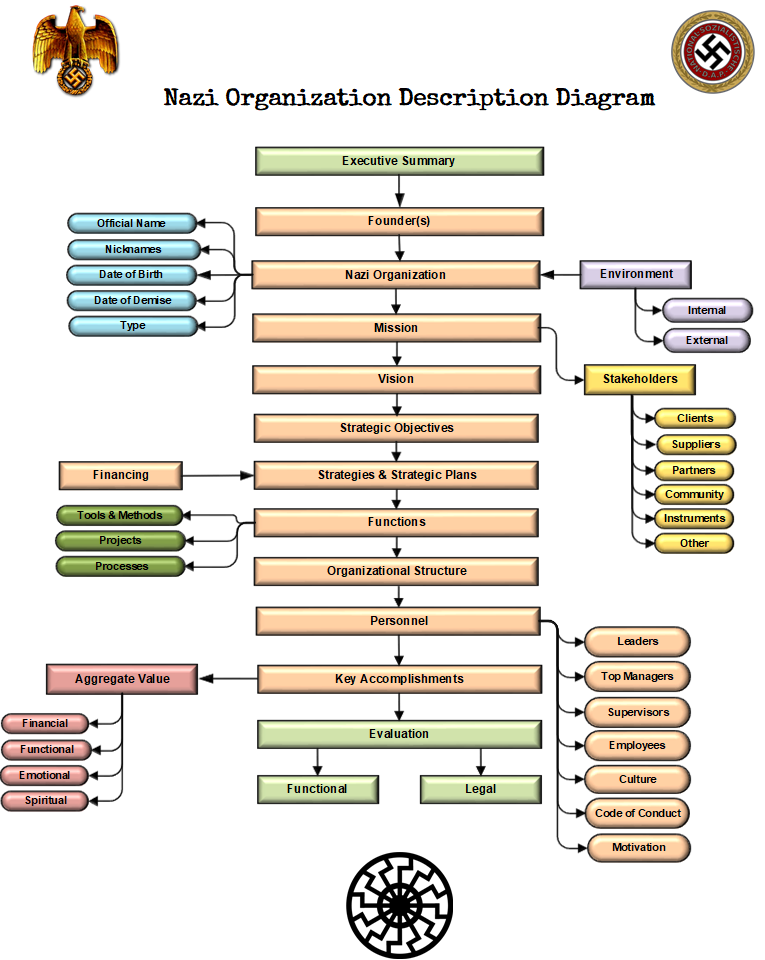
Nazi Organization Description Process
The most important components of Nazi system (Nazi Germany, Third Reich) are, obviously, Nazi organizations. Nazi Party, the SS, government ministries, Hitler Youth, Wehrmacht, etc.
To produce a genuinely comprehensive and the most user-friendly guide to Nazi Germany, it is necessary to follow the same process for the description and analysis of every Nazi organization. This process is presented in an easy-to-understand visual form in a Nazi Organization Description Diagram (see Figure A1).
Obviously, every description of every object in the Nazi system (not just an organization), must have an executive summary (as not everyone will have the time to read the whole million-word book).
The description proper will, obviously, begin with the official name of the organization, the comprehensive list of its nicknames/sobriquets (if any), founding date and the date of its official demise (i.e. when the organization ceased to exist). And, of course, the type of an organization – i.e. to which Nazi sub-system (parent organization) it belonged (Party, government, military, SS, etc.).
Obviously, it is very important to describe in sufficient detail the founder(s) of the organization in question. As well as its environment – internal (inside the Nazi state) and external (outside). No man is an island and no organization is either.
Environment of the organization (“corporate environment” in a general sense) consists mostly of key external and internal factors and the stakeholders of the organization in question.
Consequently, it is absolutely necessary to describe (in sufficient detail, of course), all stakeholders of the organization in question – clients/customers (users of its products and/or services), suppliers, partners (other external and/or internal organizations), suppliers (of goods and services necessary for its operations), instruments (e.g. slave labor) that the organization in question uses to achieve its objective, relationships with the general community (population of Nazi Germany) and other stakeholders (e.g objects such as Jews, POWs or inmates of concentration camps).
Every organization has an explicit or (more often) implicit mission and – also explicit or (more often) implicit vision. Which, obviously must be identified, structured, presented and analyzed in sufficient detail.
Every organization has (usually explicit) strategic objectives and (almost always explicit) strategic plans (financial and operational). These must also be identified, structured, presented and analyzed in the appropriate detail. As well as a very important issue – financing of the organization (where did its money come from and in which quantities).
Every organization strives to achieve its strategic objectives but on an everyday basis it performs certain functions (which also must be identified, structured and analyze as they are the raison d’être of the organization in question).
To achieve its strategic objectives and perform its everyday functions, the organization needs to employ tools & methods, undertake projects and implement certain key organizational (“corporate”) processes. And, obviously, to design and implement organizational structure (departments, workgroups, offices, etc.). Naturally, all of these must be identified, structured, described and analyzed in sufficient detail.
Objectives are achieved and functions are performed by human beings. Individuals. Personnel (human capital) of the organization in questions. Therefore, it also must be identified, structured, described and analyzed in the appropriate detail.
Leaders of the organization, its top- and middle-managers (“generals” and “officers”), supervisors (NCOs) rank-and-file employees (“soldiers”), etc. As well as (obviously) the formal and informal culture of the organization in question (its “corporate culture”), code of conduct (all Nazi organization had it), motivation system, etc.
Obviously, the most important question about any organization is about its actual accomplishments. What it actually did and if its actual results were different from its objectives (they usually were) than why.
All organizations have ultimately one and the same mission – to create the maximum possible amount of aggregate value (financial, functional, emotional and spiritual) for its stakeholders. Therefore, the accomplishments of any organization (and the Nazi ones are no exception) are measured in aggregate value.
Finally, I will perform the “performance evaluation” of the organization in question. Functional, of course (how efficient it was in achieving its objectives and whether the objectives themselves were good in the functional sense), but also legal (whether any objectives, methods and/or actual activities of the organization in question constituted a crime and whether the organization itself was a criminal one).